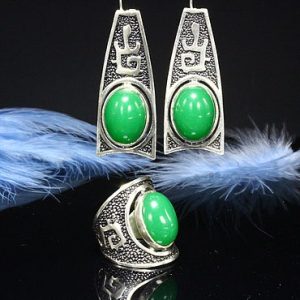




Zhaitas (jade) was considered a stone of victory by the Turkic peoples and was used to decorate knives, swords, saddles and belts. Numerous artefacts of bladed weapons with inlaid jade handles are kept in the best museums of the world.
In ancient times jade was available only to the wealthy and served as an indicator of social status. Sacral aspect of jade is its ability to affect wind and rain. Sources indicate that jade was one of the many beliefs in the magical stone used by ancient Turkic Kams and Kazakh Baqsy (shamans) to perform the ritual of invoking rain. Similar notions of magic stones also exist among Altaians, Tuvans and others. The Altaians, for example, used it not only to bring rain, but also to dispel clouds and bring about warming, which was done by a special baqsy – yadachi. Besides nephrite, jasper or jadeite could also be used. The “meteorological” abilities of the Kazakhs are also reflected in their understanding of nephrite as protection against lightning. In the worldview of the Kazakhs, jade is endowed with “victorious” power and “meteorological” abilities.


